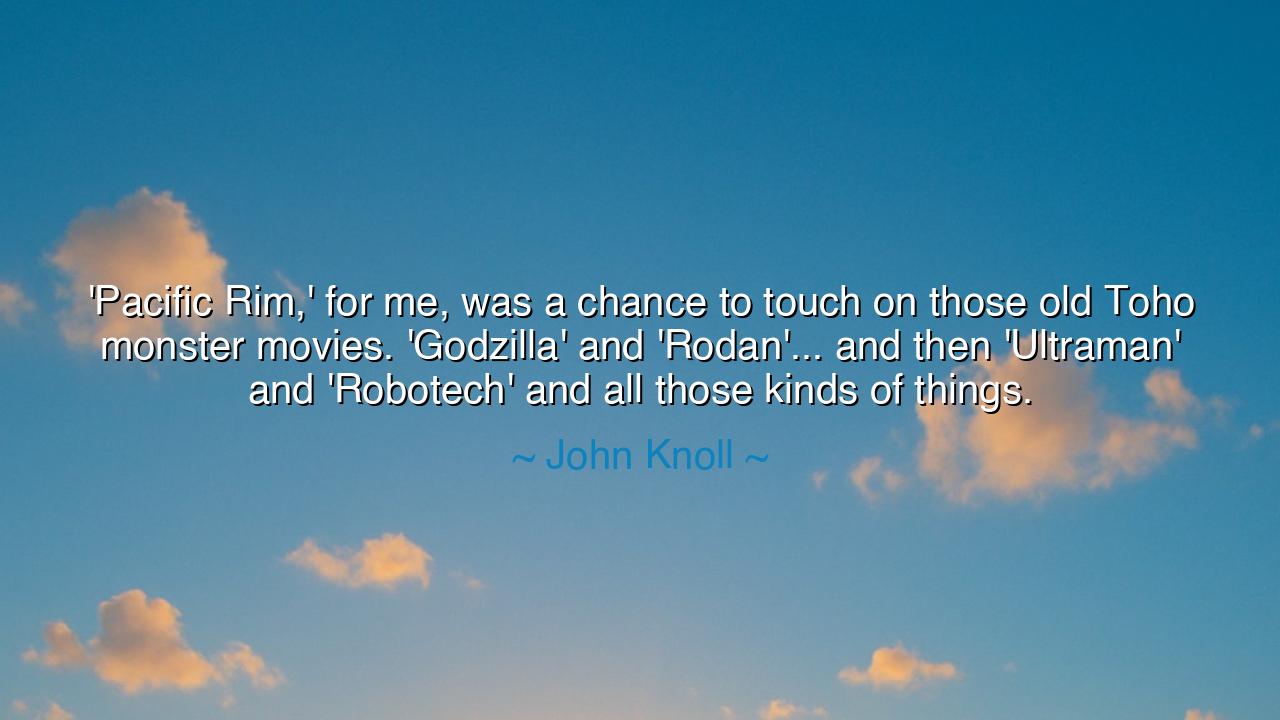
'Pacific Rim,' for me, was a chance to touch on those old Toho
'Pacific Rim,' for me, was a chance to touch on those old Toho monster movies. 'Godzilla' and 'Rodan'... and then 'Ultraman' and 'Robotech' and all those kinds of things.






In the insightful words of John Knoll, "'Pacific Rim,' for me, was a chance to touch on those old Toho monster movies. 'Godzilla' and 'Rodan'... and then 'Ultraman' and 'Robotech' and all those kinds of things," we are invited into the world of nostalgia, cultural heritage, and the power of storytelling. Knoll reflects on how modern cinema can tap into the legacy of past cultural creations, particularly the giant monster films of Japan. His statement acknowledges the deep roots that such stories have in shaping the imagination of generations, both past and present. These films, often filled with fantasy, drama, and cautionary tales, connect us to the mythic dimension of storytelling, where larger-than-life creatures are metaphors for human fears, hopes, and the eternal struggle between good and evil. Knoll's desire to honor and draw from these iconic monsters is a recognition of the lasting power of these stories in shaping culture and the human psyche.
The legacy of Toho monster movies, particularly Godzilla, can be traced to the aftermath of World War II. The character of Godzilla was not merely a monstrous creature but a reflection of the deep fear and trauma that the Japanese people faced after the atomic bombings of Hiroshima and Nagasaki. Created in 1954, Godzilla represented the terrifying power of nuclear weapons and the chaos they could bring to the world. The film was both a reflection of the post-war anxieties of Japan and a symbol of the collective fear of mankind’s potential for self-destruction. In this way, Godzilla was not just a monster on screen but a reflection of human folly and the dangers of unchecked power. Knoll’s connection to these films through Pacific Rim is a recognition of how such stories—once born out of real-world fear—continue to captivate and serve as warnings for future generations.
The ancient Greeks understood the power of storytelling in a similar vein. Their mythology was filled with gods, monsters, and heroes, each representing various forces of nature, human desire, and moral lessons. Consider the myth of Heracles and the Lernaean Hydra, a multi-headed serpent-like monster that represented the chaos and destructive forces that heroes must face. Just as Godzilla served as a metaphor for nuclear destruction, the Hydra symbolized the continual struggle against the forces of nature that cannot be easily defeated. The Greeks used monsters in their stories to convey essential lessons about courage, hubris, and the human condition. Knoll's desire to revisit these old stories is a testament to how such ancient themes continue to resonate and offer us insights into the world of today.
In modern times, the Kaiju films, such as Pacific Rim, tap into the same universal themes of human struggle against the overwhelming forces of nature, technology, or monstrous entities. The film genre serves as a reminder that, while the specifics of our fears may evolve, the deep-seated need for heroes and symbols of hope remains constant. The monsters we create in our stories often embody the challenges we cannot fully control or understand. They serve as a mirror to the fears and aspirations of society, just as Godzilla was a reflection of nuclear anxiety and Pacific Rim’s Kaiju represented unknown cosmic threats. Knoll’s tribute to these old films speaks to the power of storytelling to address humanity’s deepest fears and the potential for modern interpretations to continue this timeless narrative.
Consider the story of Frankenstein, written by Mary Shelley in 1818, a tale of man’s hubris and the monstrous consequences that arise when man seeks to control forces beyond his understanding. The creature in Frankenstein is a monster born of science and human ambition, and, much like the creatures of Toho films, it represents the unintended consequences of tampering with nature. Shelley’s work, like Godzilla and Pacific Rim, shows how monsters are often not inherently evil, but are instead symbols of the dangers of unchecked ambition and the complexity of human emotion. These monsters, through the ages, have served as mirrors, reflecting the anxieties and moral dilemmas of their time. Knoll’s acknowledgment of old Toho monster movies speaks to this ongoing cycle—how we revisit these monsters to continue exploring our own fears and desires.
The lesson Knoll’s words offer is clear: stories—whether ancient or modern—are our tools for navigating the complexity of the human condition. By looking back at old tales and drawing inspiration from them, we not only honor the cultural legacy of previous generations but also reimagine those stories for the world we live in today. The monsters of the past are not merely entertainment, but vessels of truth and warnings that continue to resonate. As we face new challenges, whether through technological advancement, war, or global crises, we must remember that the stories of monsters remind us of the need for balance, humility, and the responsibility that comes with wielding power.
In our own lives, we too can take action by embracing the lessons of the past while looking forward to the future. Just as Knoll honored the old films, we must not shy away from revisiting ancient wisdom, literature, and myths to understand the deep patterns of human nature. Let us continue to tell stories that challenge us to reflect, grow, and confront the unknown, knowing that in doing so, we shape the future with the wisdom of the past. Like Godzilla, Ultraman, and the modern Kaiju, we too must face the monsters of our time, using the stories of old to guide us toward a better, more conscious existence.






AAdministratorAdministrator
Welcome, honored guests. Please leave a comment, we will respond soon